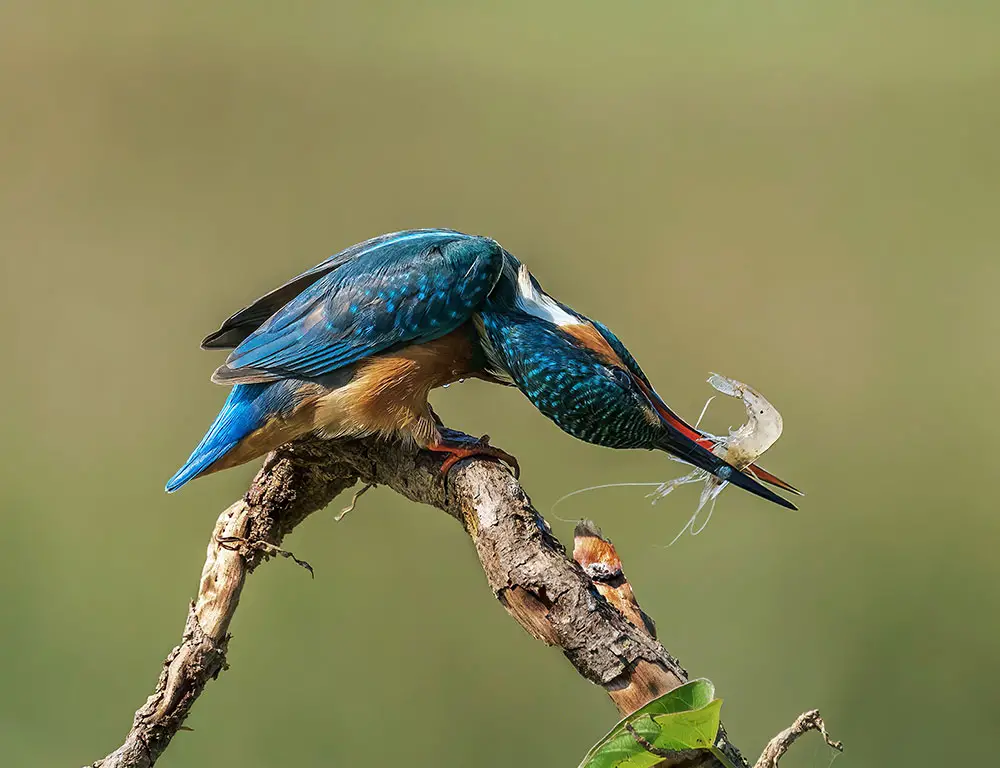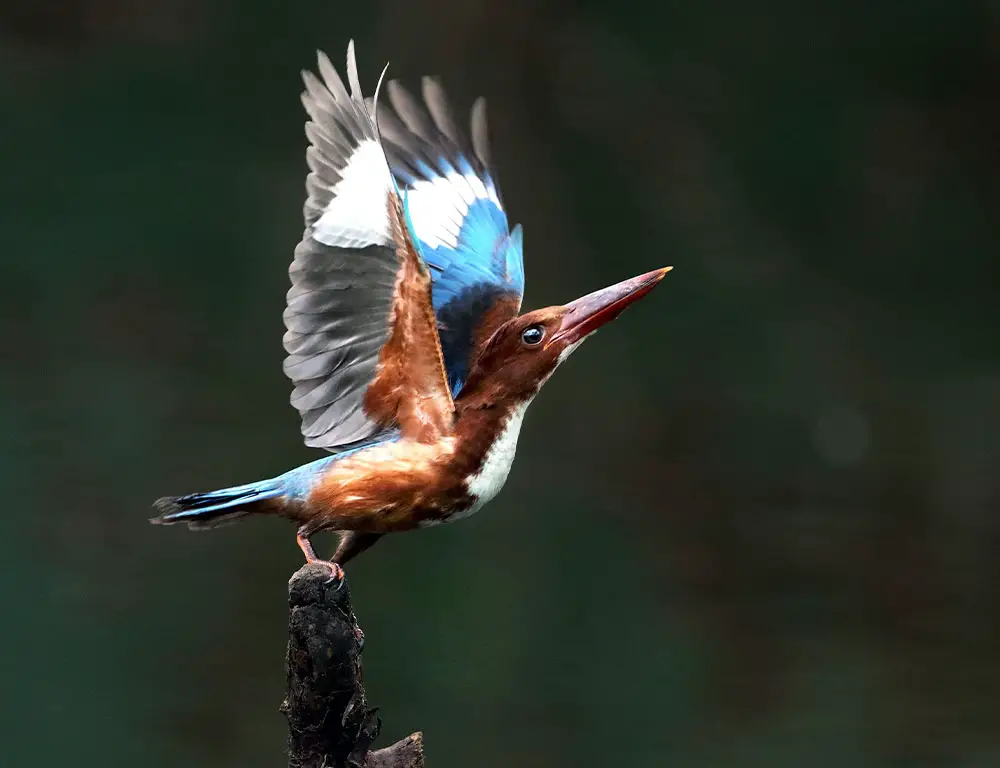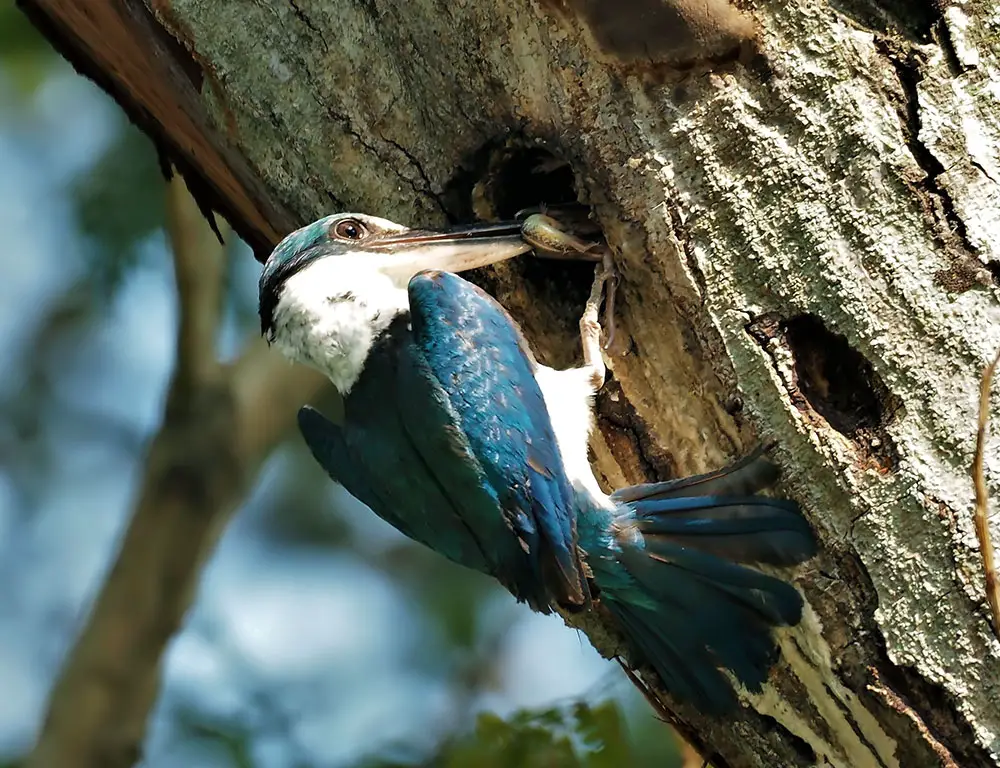In the tranquil realms of rivers, lakes, and streams, a flash of vibrant colors and a melodious call announce the presence of one of nature’s most captivating creatures – the kingfisher.
With its dazzling plumage and remarkable fishing prowess, the kingfisher holds a special place in the hearts of nature enthusiasts and birdwatchers worldwide.
From the azure waters of tropical rivers to the icy streams of mountain valleys, these charismatic birds grace waterways with their elegance and charm.
Join us on a journey into the enchanting world of kingfishers, where we uncover the secrets of their aquatic lifestyle, intricate behaviors, and cultural significance.
From their remarkable hunting techniques to their symbolic importance in folklore and mythology, kingfishers embody the timeless allure of nature’s wonders.
Prepare to be mesmerized by the beauty and grace of these avian jewels as we explore the fascinating realm of kingfishers.

Key Identifying Characteristics of the Kingfisher
The kingfisher is a stunning bird known for its vibrant plumage and distinctive features. Here are the key identifying characteristics of the kingfisher:
Plumage
Kingfishers are renowned for their bright and colorful plumage, which varies depending on the species. Common kingfishers, for example, have striking blue and orange feathers on their upperparts, with a white throat and chest.
Other species, such as the American kingfisher, may exhibit shades of green, turquoise, and rufous.
Body Size and Shape
Kingfishers are relatively small to medium-sized birds, typically measuring 10 to 20 centimeters (4 to 8 inches) in length, excluding their tail.
They have short necks and bodies, large heads, and long, pointed bills. Their bodies are compact and streamlined, perfect for diving into water to catch fish.
Bill
One of the most distinctive features of kingfishers is their long, dagger-like bills. These bills are sharply pointed and slightly curved, enabling kingfishers to catch and grasp their prey underwater efficiently.
The bills are also solid and sturdy, allowing kingfishers to deliver precise blows when striking their prey.
Head and Eyes
Kingfishers have large heads with prominent eyes positioned high on their skulls. Their eyesight is exceptionally keen, enabling them to spot prey from considerable distances.
Additionally, their eyes are adapted to see well above and below the water’s surface, facilitating their hunting efforts.
Tail
The tail of a kingfisher is relatively short and square-shaped, adding to its aerodynamic profile. In flight, kingfishers often display a distinctive dipping motion, with their tails moving up and down rhythmically as they glide low over the water in search of prey.
Feet and Legs
Kingfishers have tiny, delicate feet with short toes and sharp claws. These feet are well adapted for perching on branches and other structures near water bodies.
While kingfishers are primarily aerial hunters, they may occasionally use their feet to grasp onto prey or stabilize themselves while perched.
Flight

Kingfishers are agile and swift flyers, capable of rapid bursts of flight interspersed with gliding. Their short and rounded wings provide excellent maneuverability in dense vegetation and over water. When hunting, kingfishers often hover briefly before diving headfirst into the water to catch fish.
Vocalizations
Kingfishers are known for their distinctive calls, which vary between species. Common kingfishers, for example, produce a sharp, high-pitched “kee-kee-kee” or “tik-tik-tik” call, often heard near water bodies.
These vocalizations serve various purposes, including territorial defense, mate attraction, and communication with offspring.
Taxonomic Level and Life History of the Kingfisher
Dive into the fascinating world of kingfishers, from their taxonomic classification to their life history and ecological roles. Learn about their habitat, behavior, and conservation status as we unravel the mysteries of these colorful avian jewels.
Taxonomy
| Taxonomy Level | Classification |
| Kingdom | Animalia |
| Phylum | Chordata |
| Class | Aves |
| Order | Coraciiformes |
| Family | Alcedinidae |
| Genus | Alcedo |
| Species | Alcedo atthis |
Range Map

The range map of kingfishers varies depending on the species and geographic region. However, they are commonly associated with freshwater habitats such as rivers, streams, lakes, ponds, and wetlands.
Kingfishers are typically found in areas with clear water and abundant fish populations, as these are their primary prey.
In addition to freshwater habitats, some kingfisher species inhabit coastal areas, estuaries, and mangrove forests. These habitats provide opportunities for feeding on marine fish and other aquatic organisms.
Food Habits
Kingfishers are primarily piscivorous, meaning they mainly feed on fish. Their diet may include aquatic insects, crustaceans, amphibians, and occasionally small reptiles and mammals.
Kingfishers are highly specialized hunters, relying on their keen eyesight to spot prey from perches near water bodies. When prey is detected, they plunge headfirst into the water, seizing their prey with sharp bills.
Nesting

| Nest Location | Description |
| Nest Placement | Both male and female excavated a simple burrow, with a nesting chamber at the end lined with regurgitated fish bones. |
| Nest Structure | Usually, 4-6 eggs are laid per clutch, incubating around 3 weeks. |
| Nesting Season | Chicks hatch after approximately 3 weeks of incubation and fledge around 3-4 weeks of age, becoming independent shortly after that. |
| Clutch Size | Typically, nests during the spring and summer, with breeding pairs excavating burrows and preparing for egg laying. |
| Incubation and Care | Both parents share incubation duties, with the female primarily incubating the eggs while the male provides food. |
| Fledging and Growth | Chicks hatch after approximately 3 weeks of incubation and fledge around 3-4 weeks of age, becoming independent shortly thereafter. |
Breeding
Kingfishers are monogamous birds that typically breed during the spring and summer months. Breeding pairs engage in courtship displays, which may include aerial acrobatics and vocalizations.
Once a pair forms, they select a suitable nesting site, usually a burrow excavated into a riverbank or sandy cliff. The female lays 4-6 eggs, which both parents incubate for approximately three weeks.
After hatching, both parents care for the chicks, providing them with food until they fledge.
Conservation Status
The conservation status of kingfisher species varies depending on the region and species. While some species are considered stable and widespread, others face habitat loss, pollution, and human disturbance threats.
Conservation efforts focused on habitat preservation, restoration, and minimizing human impacts are crucial for ensuring the continued survival of kingfishers.
7 Fun Facts About the Kingfisher

Dive into the fascinating world of kingfishers with these intriguing facts that showcase these remarkable birds’ unique characteristics and behaviors.
1. Spectacular Plumage
Kingfishers are known for their stunning plumage, often featuring vibrant shades of blue, green, and orange. Their iridescent feathers serve as camouflage and play a role in attracting mates during courtship displays.
2. Masterful Hunters
Kingfishers are expert fishermen, using their sharp bills and keen eyesight to spot and catch prey underwater. They snatch fish from the water’s surface with lightning-fast dives and return to their perches to consume their catch.
3. Unique Nesting Habits
Some kingfisher species excavate burrows in riverbanks or sandy cliffs for nesting. These burrows protect from predators and harsh weather conditions, with the female typically laying her eggs on a bed of fish bones at the end of the tunnel.
4. Agile Fliers
Kingfishers are agile flyers capable of rapid and precise aerial maneuvers. They often hover briefly over water bodies before plunging headfirst to catch their prey, showcasing their exceptional flying skills.
5. Vocal Performers
Kingfishers are not only skilled hunters but also talented vocalists. They produce a variety of calls and vocalizations, including loud rattles, chattering calls, and melodic songs, which they use for communication and territorial defense.
6. Monogamous Relationships
Many kingfisher species form monogamous breeding pairs, with individuals often staying together for multiple breeding seasons.
These devoted couples engage in elaborate courtship displays, reinforcing their bond through mutual grooming and food sharing.
7. Cultural Significance
Throughout history, kingfishers have held cultural significance in various societies worldwide.
In ancient Greek and Roman mythology, they were associated with gods and goddesses of the sea, while in some indigenous cultures, they symbolize peace, prosperity, and good fortune.
FAQs
Where do kingfishers live?
Kingfishers are found in various habitats worldwide, including freshwater bodies such as rivers, streams, lakes, ponds, coastal areas, estuaries, and mangrove forests. They prefer habitats with clear water and abundant fish populations.
What do kingfishers eat?
Kingfishers are primarily piscivorous, meaning they mainly feed on fish. However, their diet may include aquatic insects, crustaceans, amphibians, and occasionally small reptiles and mammals. They use their sharp bills to catch prey, often diving into the water from perches.
How do kingfishers catch their prey?
Kingfishers employ a sit-and-wait hunting strategy, perching near water bodies and scanning for prey. When they spot a suitable target, they dive headfirst into the water, seizing the prey with their sharp bills. They then return to a perch to consume their catch.
Are kingfishers social birds?
While kingfishers are generally solitary hunters, they may be observed in pairs or small family groups during the breeding season. Outside of the breeding season, they tend to be more solitary, defending individual territories along waterways.
Are kingfishers migratory birds?
The migratory behavior of kingfishers varies depending on the species and geographic region. While some species are resident year-round in their range, others undertake seasonal migrations in response to changing environmental conditions.
Conclusion
To wrap it up, the kingfisher emerges as a symbol of beauty, resilience, and harmony in the natural world. Through its vibrant plumage and agile hunting techniques, it captivates our imagination and inspires reverence for the wonders of aquatic ecosystems.
As stewards of the environment, we are responsible for safeguarding the habitats and waterways upon which kingfishers depend for survival.
By conserving these precious habitats and minimizing human impacts, we ensure that future generations can continue to marvel at the splendor of these avian jewels.
Let us cherish and protect the kingfisher, preserving its legacy as a beacon of tranquility and grace along our planet’s waterways.
May the iridescent beauty and melodious calls of kingfishers continue to grace our waterways, reminding us of the importance of preserving the delicate balance of nature for generations to come.
